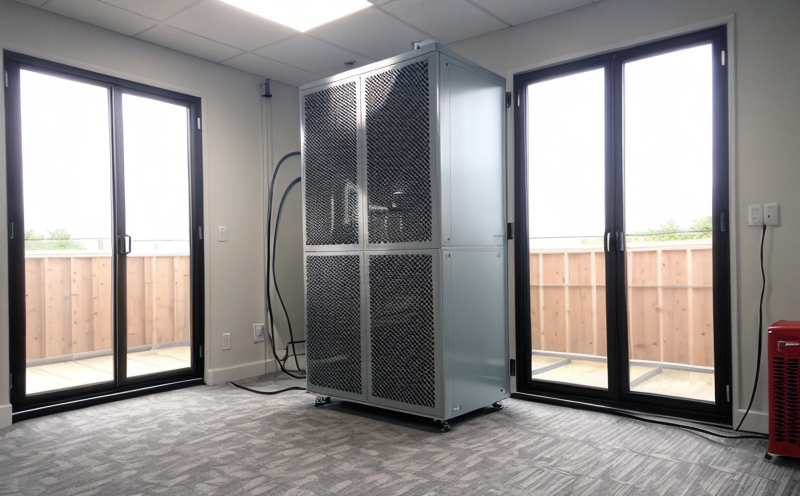ISO 14644-1 Cleanroom Airflow Uniformity Testing
The ISO 14644-1 standard provides a framework for ensuring that cleanrooms meet the necessary requirements regarding air quality, which is critical in environments where particulate contamination can significantly impact product quality and safety. This standard specifically addresses airflow uniformity within cleanrooms, focusing on maintaining consistent air distribution across all areas of the space.
Our ISO 14644-1 Cleanroom Airflow Uniformity Testing service ensures that your facility adheres to these stringent requirements by employing advanced testing methodologies designed to detect any deviations from specified limits. This includes the use of sophisticated instruments capable of measuring velocity and direction at multiple points throughout the cleanroom.
During our testing process, we follow all relevant sections of ISO 14644-1, ensuring that every aspect is thoroughly evaluated. We focus on critical parameters such as mean air velocity (MAV), velocity uniformity, and directional uniformity to determine if they meet your specified criteria. Our technicians are trained to handle complex equipment with precision and ensure accurate results.
Our service covers the entire range of cleanroom types and sizes, from small laboratories to large manufacturing facilities. By adhering strictly to ISO standards, we guarantee that you receive reliable data which can be used for both compliance purposes and continuous improvement initiatives within your organization.
The importance of proper airflow management cannot be overstated; even minor discrepancies can lead to significant issues in terms of product quality or patient safety when dealing with pharmaceuticals or medical devices. Our team works closely with clients to understand their unique needs before initiating testing, ensuring that all aspects relevant to their specific application are addressed.
Our commitment extends beyond just conducting tests – we provide detailed reports outlining our findings along with recommendations for corrective actions if necessary. These comprehensive documents serve not only as proof of compliance but also as valuable tools for ongoing process optimization and quality assurance efforts.
Why It Matters
The importance of maintaining proper airflow within cleanrooms cannot be overstated, especially given the stringent requirements set forth by ISO 14644-1. Properly controlled airflows are essential for creating and sustaining an environment where contamination levels remain below acceptable thresholds.
When designing or modifying a cleanroom facility, it is crucial to consider how different components of the system will interact with one another over time. Factors such as temperature control, pressure differentials between zones, and the placement of HVAC units all play critical roles in determining overall airflow patterns.
Airflow uniformity ensures that there are no hotspots or dead spots where particulates may collect more easily than others areas. This is particularly important for industries like pharmaceuticals, electronics manufacturing, biotechnology research labs, and any other field requiring ultra-pure environments free from contaminants.
By ensuring that airflow remains consistent across all parts of the cleanroom space, we can help prevent defects in products being manufactured or processed inside these facilities. In addition to preventing costly rework due to contamination issues, maintaining proper airflow helps protect both workers' health and safety by reducing exposure risk factors associated with poor air quality.
The consequences of failing to meet ISO 14644-1 requirements can be severe not only for those directly involved but also extend outward into supply chains and customer relationships. Compliance failures might result in product recalls, lawsuits, regulatory penalties, or loss of market share among competitors who adhere more strictly to industry best practices.
Industry Applications
| Industry Sector | Application Area |
|---|---|
| Pharmaceuticals | Ensuring consistent product quality through controlled environments. |
| Biotechnology Research Labs | Maintaining sterile conditions necessary for sensitive experiments. |
| Electronics Manufacturing | Avoiding particle contamination that could cause defects in electronic components.|
| Medical Device Production | Creating safe operating environments to reduce the risk of product failure or injury. |
| Food & Beverage Processing | Preventing cross-contamination between different products being processed simultaneously. |
| Aerospace & Defense | Maintaining high levels of cleanliness required for mission-critical operations. |
| Semiconductor Fabrication | Preserving the integrity of semiconductor wafers by minimizing particulate matter accumulation. |
| Advanced Manufacturing | Supporting complex processes that demand precise temperature and humidity control. |
| Test Parameters | Description |
|---|---|
| Mean Air Velocity (MAV) | The average speed of air passing through the cleanroom at various points. |
| Velocity Uniformity | The consistency of airflow across different sections of the cleanroom. |
| Directional Uniformity | The alignment and directionality of the airflow throughout the entire space. |
| Pressure Differential | The difference in air pressure between adjacent areas to maintain desired flow patterns. |
| Particle Counting | Measuring the number of particles above a certain size within specified volume ranges. |
| Air Change Rate (ACH) | The frequency at which outside air is introduced into and exhaust from the cleanroom per hour. |
International Acceptance and Recognition
ISO 14644-1 has gained widespread acceptance across various sectors due to its comprehensive approach towards defining cleanliness levels in controlled environments. It is widely recognized globally for setting benchmarks against which other standards can be compared.
The standard's emphasis on scientific rigor combined with practical applicability makes it highly valued among professionals working within regulated industries like healthcare, electronics manufacturing, and pharmaceuticals. Many organizations choose to adopt ISO 14644-1 not only because of its relevance but also due to the international recognition it brings.
By adhering to these internationally accepted guidelines, companies demonstrate their commitment to quality assurance while simultaneously enhancing their reputation among customers seeking reliable products produced under stringent environmental controls. This can contribute significantly towards building trust and fostering long-term relationships with partners and clients alike.





